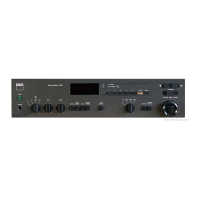www.SteamPoweredRadio.Com
If the Tuning rocker is held down with continuous
pressure rather than just tapped, the tuning pauses briefly
and then scans rapidly up or down
in
frequency.
Thus, to manually tune a station, the procedure is to
press continuously on either side of the Tuning rocker until
the tuned frequency is close to the desired broadcast fre-
quency, and then fine-tune by tapping the Tuning rocker
until the digital frequency display exactly matches the sta-
tion's broadcast frequency as listed
in
a local newspaper
or broadcasting guide. If you know the exact broadcast
frequency, simply set the tuner to that frequency. If you
know only the approximate frequency, tune to the vicinity
of the station and then fine-tune for best sound. On FM,
fine-tune until the center-tune indicator (between the
triangular off-tune indicators) is illuminated.
21.
SEARCH
MODE
(FM
ONLY)
When the SEARCH button
is
engaged, the tuner scans
in
a station-by-station mode rather than in small frequency
increments. When the Up/Down Tuning rocker is tapped,
the tuner scans up
or
down
in
frequency and automatically
stops at the next station whose signal
is
strong enough for
good reception.
If you want to tune to a weak station, or if you want to
fine-tune the tuner manually, disengage the SEARCH mode
(button OUT), allowing the Up/Down Tuning rocker to tune
in
small increments.
A
NOTE
ON
OVERLOAD
PROTECTION
Because NAO amplifiers sound so clean and musical
when driven beyond their nominal power ratings and when
10
used to drive low-impedance loudspeakers, you may be
tempted to stress this amplifier beyond its design capacity.
It can safely and cleanly drive impedances as low as 2 ohms
with wide-range musical signals whose peak level
is
50 watts
or more, but it may overheat if called upon to deliver high
power continuously into a low impedance.
Thus you may play music at volume levels which cause
the brief transient peaks and climaxes
in
music to exceed the
amplifier's rated power by a considerable margin (and with
Soft Clipping the music will continue to sound good at those
high peak levels). But if you overdrive the amplifier continu-
ously, rather than only on brief musical peaks, the output
transistors may overheat.
This
is
particularly likely if you set the SPEAKER
IMPEDANCE switch to 8 OHMS and then try to drive very
low impedances at high volume levels. Severe abuse of this
type could cause internal fuses to blow
in
order to protect
the amplifier. These fuses are not intended to be replaced
by the user; if the amplifier shuts down you should return
it
for service.
If this occurs, you should examine whether a pattern
of unintended abuse may have contributed to the failure.
For example you may have a loose strand of speaker wire
causing a partial short-circuit either at the speakers or at the
amplifier's speaker terminals. The impedance of your speak-
ers may be lower than you think; if you are not sure, set the
SPEAKER IMPEDANCE switch to 4 OHMS.
You
may
be
com-
bining maximum bass boost with high volume settings. Or
you may simply be playing the music at continuously high
power levels that demand a larger amplifier with high-power
transistors and bigger heat-sinks.

